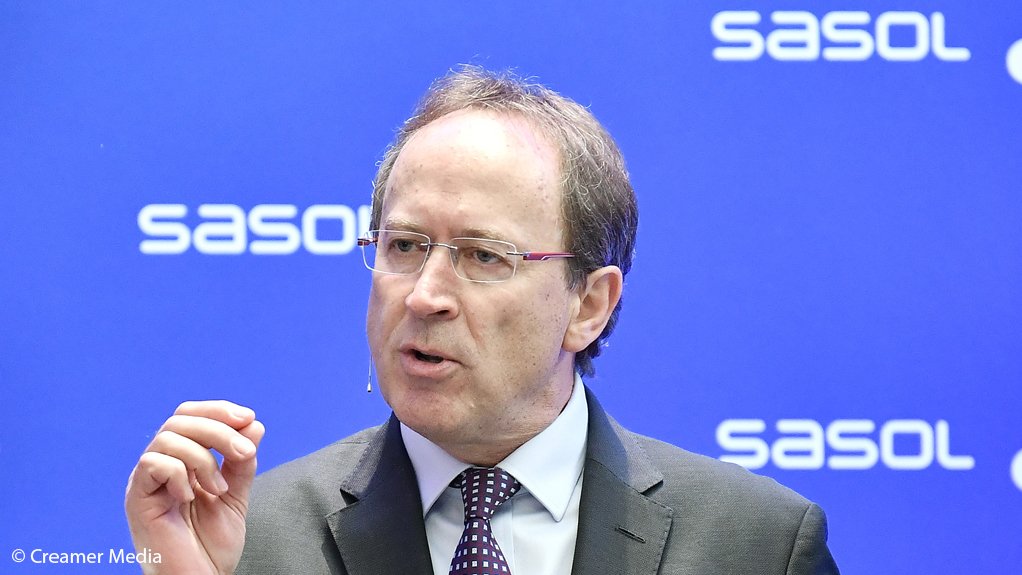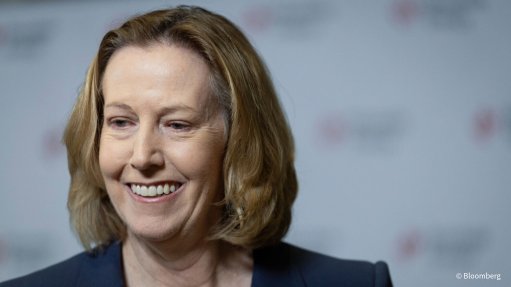Sasol prepares to ramp up decarbonisation capex from 2025
Energy and chemicals group Sasol expects to invest the bulk of the R15-billion to R25-billion it is budgeting to facilitate a 30% reduction in its carbon emissions by 2030 between 2025 and 2027, having spent only modest capital on such projects to date.
The expenditure forms part of the JSE-listed group’s yearly ‘maintain and transform’ capital budget, which is expected to rise to between R26-billion and R27-billion in its 2023 financial year.
Sasol will invest between R500-million and R1-billion during the year on projects designed to improve its environmental performance ahead of a scale-up in such expenditure from 2025 onwards.
The bulk of the ‘transform capital’ will be directed towards the introduction of process changes particularly at the group’s Secunda complex, which is regarded as one of the largest single-site emitters of carbon dioxide globally.
These include technology changes allowing for the displacement of coal with gas, the possible briquetting of coal fines to reduce its use of mined coal and the ramping down of coal-fired boilers as it begins procuring renewable energy from independent power producers (IPPs).
The company says it has agreed key terms with IPPs for more than 600 MW of wind and solar to be introduced before 2025 and is planning to procure 1 200 MW by 2030.
CEO Fleetwood Grobler reports that Sasol is working on future gas supply options, including the possible integration of imported liquefied natural gas (LNG) through Maputo, in Mozambique.
It has, however, been able to extend the gas supply “plateau” from Mozambique by two years to 2028, following infill well drilling.
The prospect of a “gas cliff” has come into focus again recently after Sasol Gas announced, and later delayed, the implementation of a 96% hike in the price of pipeline gas from August 1. Had the increase been introduced, the price of gas charged to South African customers would have increased from R68.39/GJ to R133.34/GJ.
The Industrial Gas Users Association of Southern Africa warned that its members were not only facing the prospect of an “untenable” hike in prices, but also the prospect of gas shortages as production from Sasol’s Mozambican wells tapered.
Sasol says drilling is under way in a bid to find more gas and that it is now moving to explore acreage adjacent to its existing production wells.
The company is also in advanced talks to finalise a term sheet for 40 to 60 petajoules (PJ) of LNG as additional incremental gas supply toward the latter end of the decade over and above its current 160 PJ requirement.
GREEN HYDROGEN & NATREF REPURPOSING
In parallel, the group intends moving ahead with an initial green hydrogen project at Sasolburg, in the Free State, where it will convert an existing 6 t/d electrolyser to operate on renewable electricity.
The final investment decision for the green hydrogen project has been made with the aim of producing the first green hydrogen volumes towards the end of 2023. Details of the project will be announced once Sasol’s investment partner, the Industrial Development Corporation, also approves the investment.
The group is also studying larger green hydrogen prospects that are likely to proceed only after 2030, including the possible creation of a green hydrogen hub at Boegoebaai, in the Northern Cape.
Grobler expresses particular enthusiasm for using green hydrogen to produce a “drop in” sustainable aviation fuel (SAF), which will be produced using the group’s existing Fischer-Tropsch assets.
“SAF remains one of the most promising pathways for the hard-to-abate aviation sector to decarbonise in future.
“The SAF drop-in offering is an attractive aviation-fuel solution and the market is expected to grow massively in the years to come,” Grobler says, revealing that it is currently refining its “go-to-market” strategy in collaboration with others.
He has also announced that a low capital solution has been found to produce Cleaner Fuels 2-compliant diesel at the Natref refinery, in the Free State, which it operates together with TotalEnergies.
In addition, a study is under way on the potential to produce clean petrol at the facility by repurposing it to be a green hybrid refinery.
“This includes the introduction of bio-based feedstock, as a sustainable pathway to transition the refinery to meet the country's clean-fuels compliance standards and reduce greenhouse gas emissions.
Grobler says the capital costs will be significantly less than the initial R4-billion price tag placed on upgrading of the refinery to produce to the clean-fuels specification.
Grobler says the group’s strong financial performance of 2022, during which earnings per share surged by more than 100% to R62.34 a share and Sasol declared is first dividend (R14.70 a share) since 2019, has created a sound platform for a “self-funded transition”.
The company will also launch a venture capital fund later this year, which will specifically support green-economy start-ups.
However, CFO Hanré Rossouw says the company is keeping close tabs on South Africa’s carbon tax and the impact it could have on the viability of the business that, if threatened, could undermine its own green transition.
“We are fully committed to 30% greenhouse gas reduction, which is in excess of the country's commitments.
“And I think we've got to be mindful that the tax, if and how it’s implemented, does not destroy the base business and the greening of our industries in South Africa,” Rossouw explains, adding that, if there is no Sasol, then there's no hydrogen business.
Sasol says the recently proposed $20 carbon pricing rate by 2026, if implemented, will have an adverse financial impact for Sasol.
“In a conservative scenario, assuming all allowances fall away and the increase in price is
applied, Sasol would need to consider trade-offs to balance the people, planet and profit agenda,” the company says, while stressing that consultations are still under way on the final structure.
Article Enquiry
Email Article
Save Article
Feedback
To advertise email advertising@creamermedia.co.za or click here
Comments
Press Office
Announcements
What's On
Subscribe to improve your user experience...
Option 1 (equivalent of R125 a month):
Receive a weekly copy of Creamer Media's Engineering News & Mining Weekly magazine
(print copy for those in South Africa and e-magazine for those outside of South Africa)
Receive daily email newsletters
Access to full search results
Access archive of magazine back copies
Access to Projects in Progress
Access to ONE Research Report of your choice in PDF format
Option 2 (equivalent of R375 a month):
All benefits from Option 1
PLUS
Access to Creamer Media's Research Channel Africa for ALL Research Reports, in PDF format, on various industrial and mining sectors
including Electricity; Water; Energy Transition; Hydrogen; Roads, Rail and Ports; Coal; Gold; Platinum; Battery Metals; etc.
Already a subscriber?
Forgotten your password?
Receive weekly copy of Creamer Media's Engineering News & Mining Weekly magazine (print copy for those in South Africa and e-magazine for those outside of South Africa)
➕
Recieve daily email newsletters
➕
Access to full search results
➕
Access archive of magazine back copies
➕
Access to Projects in Progress
➕
Access to ONE Research Report of your choice in PDF format
RESEARCH CHANNEL AFRICA
R4500 (equivalent of R375 a month)
SUBSCRIBEAll benefits from Option 1
➕
Access to Creamer Media's Research Channel Africa for ALL Research Reports on various industrial and mining sectors, in PDF format, including on:
Electricity
➕
Water
➕
Energy Transition
➕
Hydrogen
➕
Roads, Rail and Ports
➕
Coal
➕
Gold
➕
Platinum
➕
Battery Metals
➕
etc.
Receive all benefits from Option 1 or Option 2 delivered to numerous people at your company
➕
Multiple User names and Passwords for simultaneous log-ins
➕
Intranet integration access to all in your organisation



















